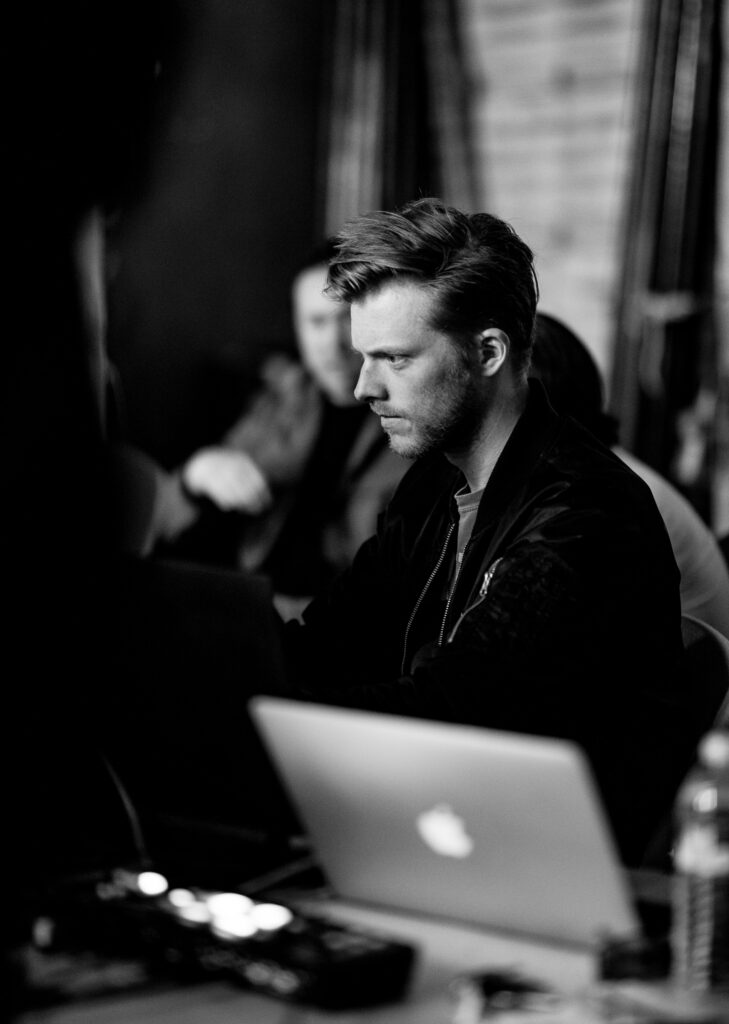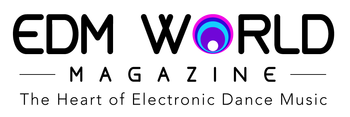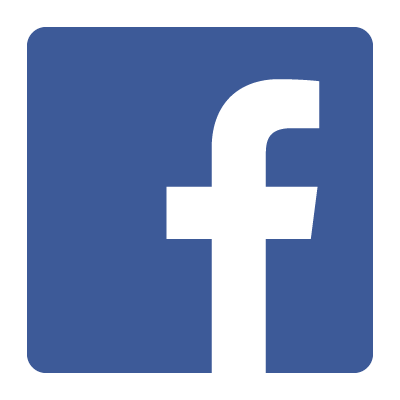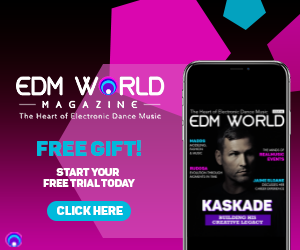23 Feb Gabe Damast’s Experiences as a VJ for Zedd
In This Article (Click on a section to quickly go to it)
 Gabe Damast’s Experiences as a VJ for Zedd
Gabe Damast’s Experiences as a VJ for Zedd
By Danielle Ilag
*This interview is older and was in our Issue 62 magazine.
Gabe Damast, also known as @_Sillygabe_ on Instagram, is a motion graphics designer and an audiovisual producer. Having previously worked with Paramount Pictures in their music department, Gabe’s background of working with creative teams and editing films better assisted him when he became Zedd’s VJ in 2012 as Zedd was opening for Tiësto in Phoenix.
Since then, Gabe has created multiple audiovisual collaborations with Zedd as technology is growing in this niche of the music industry. Check out a few of his visuals clips on his website here.
When did you realize you wanted a career in the live music sector of the music industry?
Honestly, I didn’t realize it until I was offered my first gig! Music has always been the biggest driving force in my life, but up until my early 20s, all my focus was on pursuing a career in audio engineering and sound design.
During college, I dove into live event promotion and production. Through meeting some other very young and talented people, I slowly saw that a career in the live music sector of the music industry could be a reality for me, but it was a slow realization! Even after I started VJing shows, for the first year I felt like it wasn’t real life and could disappear at any second.
What did you want to be when you were younger?
Like most young kids, I had a rotating list of ambitions for my future self. The big ones were probably an architect, LEGO designer, Disney imagineer, and animator.
When you were on tour, what was your day-to-day schedule like?
One of the exciting things about touring is that every day is different! When things are busy and lots of shows are happening, there is usually a rhythm I would fall into.
I’d wake up early at the hotel and eat breakfast if there was time. Next, I’d be driven to the airport and if there wasn’t time for breakfast at the hotel, I’d grab something quick near the gate. I would sleep on the plane because I probably did not sleep enough the night before. After landing, I would be driven straight to soundcheck.
At the venue, I would check the video screens and confirm that my mapping is correct and that the video show looks like it should on the local production. I would then be taken to the hotel to maybe nap if there was time and then eat dinner and kill some time before driving back to the venue for the show. After the show, I would either hang out for a bit, go back to the hotel to sleep, or go straight to the airport.
Rinse and repeat.
What skills are important to succeed in your job?
A friend of mine said this to me once and it has stuck with me ever since. Touring involves three general skills which are creativity, reliability, and technical expertise. If you have all three, then you’ll do great. If you only have two, you can probably still make it, but you won’t thrive. With only one of these under your belt, GOOD LUCK!
Technical know-how only takes you so far if you don’t have the creativity to let it shine. If you are a pain to work with and don’t show up on time, word will spread quickly, and soon you will not be asked back to work. Life on the road is exhausting and demanding so you have to make sure to take care of yourself physically and mentally. It’s so important to maintain professional relationships and ensure you don’t burn out.
What are your least and most favorite aspects of your job?
My least favorite aspect of my job is definitely going straight to the airport after a show. Depending on how short the flight is that can be TORTURE. Ironically, my favorite aspect of my job is traveling and doing shows all over the world while seeing how audiences in completely different continents react to the same music. In a world that can at times seem so divided, it is amazing to see how music unites us all across the globe.
What was the first event you VJed?
A Zedd show in 2012 opening up for Tiësto in Phoenix.
What is your creative planning process?
Wow, it changes constantly depending on the show! If I can get a hold of the music I am going to be working with, that is a HUGE help. I’ll listen through to the songs or DJ set and start organizing video clips based on energy level and mood. I constantly try to think of a story arch by building intensity levels up and down so the show feels like it has somewhat of a narrative.
Do you hear an artist’s mix before the show? What sense of direction do you receive from the artist?
I always ask for the music! I much prefer working with artists who want to be involved in their visual show. To me, video content feels like an extension of the music so they MUST be closely linked.
I’m lucky enough to have been working with the same artist for a long time so we have a pretty solid system in place for planning out new moments in the show. We have a constant dialog going about new music and visual moments we want to incorporate. I think the show benefits immensely from that type of open communication.
What is the shortest amount of time you’ve had to prepare for an artist’s show? What did this experience teach you?
Very early on in my career, we had a series of extremely unfortunate travel delays before a music festival in London. By the time we arrived at the site, our set was already supposed to have started twenty minutes ago and the crowd was waiting eagerly.
We literally got out of the car and ran the last bit. Everything was already set up on stage, but I had to race through the crowd to get to the front of the house and set up my laptop. I heard the intro track starting before I even had my computer booted up and I don’t think I’ve ever plugged in my MIDI controllers quicker than I did on that day.
My biggest takeaway from that experience was to get as many things ready ahead of time as possible. Always make sure your cables are neatly coiled after each show because a tangle might set you back a few precious seconds on the next one!
How important were an artist’s visuals for EDM events when you first started in the industry vs. the importance they hold now?
When I started VJing in 2012, live visuals already went hand in hand with electronic music. But even five years earlier, many festivals did not put screens on their stages and many artists did not invest in creating a unique visual accompaniment for their show.
It has been really amazing to watch this niche of the music industry blossom recently as technology and interest in this career path have grown. This feels like such an exciting time to be involved in this field!
I often think about how for decades, electronic music was played mostly in nightclubs where the focus of the room was the dancefloor and the people on it. The DJ was probably off in some corner or hidden behind a wall where no one could see them. No one was staring at the DJ and no one was watching LED walls while they danced.
This genre of music came from those dark, sweaty, primal places. It has come a long way to where we are now with crowds of 50,000 people all jumping up and down at the same time on the Ultra mainstage while one DJ pounds their fist and millions of pixels strobe to the beat.
Who is one of your dream artists to work with?
I love Max Cooper’s live visuals. It would be an honor to work with him at some point!
How do you find different ways to push the boundaries of VJing?
Right now, a lot of my focus is on animation and content creation. Rendering out videos ahead of time takes more planning, but it enables really awesome audio-visual synchronization. I’m also exploring the possibilities of running real-time environments in Unreal Engine to allow more flexibility during the show.
Life can be an incredible full circle because things can truly manifest with hope and hard work. Where were you in your career five years ago and where do you see yourself five years from now?
Five years ago I was just starting to dabble in animation and creating my own video content. That’s probably the biggest difference between my career then and now. In five more years, who knows! Maybe I will be focusing more heavily on building entire shows for artists from the ground up.
Now that the industry has been hit by COVID-19 and quarantine, what are your interests outside of VJing?
The pandemic has done disastrous things to our industry and the people working in it. I’m thankful to have my animation work outside of touring right now, but in general, I have a lot more free time than before.
A silver lining for me has been the abundance of time that I have to focus on learning new skills, and most importantly to take a REST from the insane travel schedule that I’ve been on for the past eight years. Riding my bike, hikes, camping, strengthening bonds with friends, and other qualities of life enhancements have been abundant and joyful the past few months.
How do you keep yourself inspired?
I keep myself inspired with creative input all the time by observing nature, reading about technology, watching movies and short films, journaling, and listening to music. These are the biggest ones for me.
What is your dream job?
Working at Pixar might be a sweet deam job.
How do you define success in what you do?
I define success in what I do by asking myself questions like, “Do I feel artistically fulfilled? Am I surrounded by the music I enjoy? Can I support myself financially with my work?” If I answer them when t ayes then I am feeling successful.
In what moment have you felt like you lived up to your own expectations?
I guess my expectations for myself have evolved a lot over the years. A common thread probably is my consistent emphasis on musical timing when I’m running visual shows. The years I spent playing in jazz bands and learning complex musical syncopation has translated into the visuals I work with. I think it’s a good thing!
What is your best piece of advice for someone searching for their own creative niche in the music industry?
Pick something to specialize in and then show up. Even if no one asks you to, show up. Then keep showing up, again and again. It can be discouraging when you are not immediately recognized or seen for your talent or abilities so sometimes it is only through persistence that you will be noticed.
Take no pay gigs. Take low paid gigs. Do anything you can to get in front of people who are already working in the industry. You never know who may need help with something so making yourself known is the best thing you can do in my opinion.
If you like making digital art, share it. Tag people you admire. Direct message accounts you would like to work with. But most importantly, just keep doing what you like doing. If you truly have a passion for something I believe it will show up in your work. Be consistent and keep going even when you feel discouraged.



No Comments